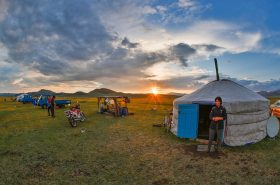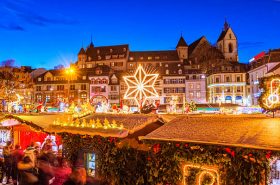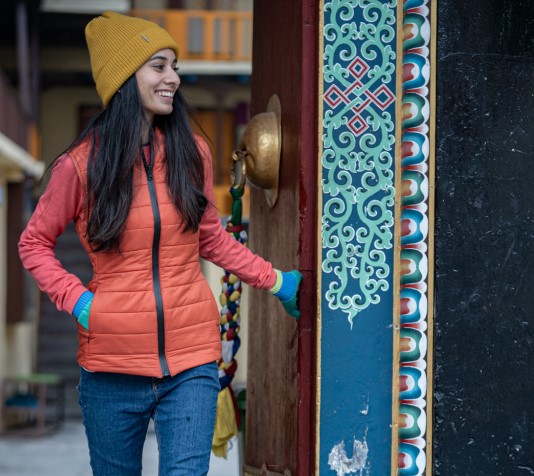
The high Himalaya, that abode of the Gods, is generally thought to be a summer destination. Since most pretty Himalayan regions are accessed through high mountain passes which get snowed out during the winter season, driving there is out of the question. However, it is a little known fact that the region of Spiti can be accessed throughout the year.
Spiti is essentially a hidden corner of India, which the BRO has built roads to because Tibet, hence China, sits right across the border. But the craggy and steep mountains that this region is dominated with haven’t relinquished tarmac worthy surfaces so easily. The roads are narrow, prone to landslides and crumbly at the edges. The brilliance of the BRO lies in the fact that they’ve built the roads skirting the mountainsides at a low altitude which means unlike the road from Manali to Leh, Ladakh, the road from Shimla to Kaza, Spiti remains largely motorable during the winter. I say largely because it might close for a day or 5 during heavy snowfall but it is generally cleared by the PWD.
The region of Spiti being in a rain shadow region itself doesn’t see incessant snowfall. It might snow for a day or two but these snowfall bouts are few and far between. Once it snows, because of the constant sub-zero temperature that the region experiences throughout winter, the snow stays on the ground right until summer or end April or May.
It is not your usual Himalayan drive and you need to make some preparations before you attempt this hard but intensely beautiful road trip.
1. Frozen Waterfalls
Since the temperatures drop rapidly to the region of -25 degrees C, waterfalls flash freeze and driving past them is like peeping into a fairy tale where a witch or a wizard has cursed the waterfall into stillness. It just stands there stopped in mid-flow.
2. The chance to experience some real winter
The winter we experience in Bombay is a sweltering joke. Maybe Delhi is better, but the smog that settles due to the cold makes it unpleasantly harsh. In the high desert of Spiti, the cold is crisp, the sky is blue and the air is so fresh that it sometimes actually smells funny to the urban nose.
3. To get away from it all
Spiti is quite a popular summer destination and it can get quite crowded then. But in winter you have to be a little mental to come here and hence you have the region almost all to yourself. There is no network and even when there is a cell phone signal, your phone will be so cold that it will probably refuse to charge.
4. To try and spot some wildlife
The prize, of course, is the Himalayan Snow Leopard that comes down from the heights during winter. While it is not very easy to catch a glimpse off, it is not impossible either and if you do then oh what a majestic sight it is. Besides that, there is the Himalayan Blue Sheep and Himalayan Fowl. You might also see jackals and wolves.
5. For pure and undiluted adventure
Driving to Spiti isn’t for the faint-hearted. But for the adrenaline rush and adventure seeker, it delivers what they seek in full measure. The roads are treacherous to drive, a blizzard is always a probability, the cold creeps into everything and sometime you might be stuck in a place for days thanks to a snowstorm to a broken bridge or road. It is all part of the great escapade that visiting Spiti in winter is.
Preparations you should make and things you should remember
Gear
I can’t stress the importance of having good gear enough. Your winter wear should be capable, technical and shouldn’t restrict your movement or bog you down.
You will certainly need layers since that you can pull off or put on as the temperature rises or falls respectively. You will need gear to keep the cold out of your ears, head, hands, legs and feet.
Good shoes with a great grip and preferably ones that are waterproof are essential since you will be walking in snow most of the time.
It is imperative to carry a good pair of sunglasses, and here function should take preference over form. The sky is clear, the sun is bright and the snow is dazzling white. And, this is a perfect recipe for snow blindness. If you step out during the day, always have your sunglasses on.
Sunscreen is another must carry accessory because while your feet could be freezing during your trek in the snow your face could be getting very badly sunburnt.
Sleeping bags, portable camping stoves, towing straps and emergency provisions are all essentials for this trip should there be any unforeseen events or delays.
The car
You need a very capable car to attempt a trip to Spiti during the winter. The key factors should be, great tyres – preferably ATs (All-Terrains), high ground clearance and 4 wheel drive with high and low ratio options.
You also need to carry tarpaulins that you will have to place between the engine and the bonnet when you park the car. This is to retain the heat in the engine and keep it warm. Always start the car every 12 hours and idle it till it reaches its optimum operating temperature even if you aren’t going anywhere that day. This is to keep the car from freezing solid.
If you have a diesel car and a metal fuel tank you can even light a fire under the tank to keep the diesel warm.
On the road
Finally, you need a certain amount of skill to attempt this road in winter. While packed snow is quite grippy and doesn’t need snow chains, you definitely should carry a pair since the need might arise.
And on ice and snow, all your acceleration, braking and turning should be smooth and gentle. Rapid changes in direction or hard braking or acceleration can send you into a skid or a slide that can have dire if not fatal consequences.
Just having them is not enough. Practice putting them onto the wheels. Remember that you might have to do this under extreme conditions of cold and snow.
The roads are very narrow and since they are snow-logged you can’t tell where the edges are so watched out for that. Often you might have to back up to let oncoming traffic pass. This requires patience and skill. Ask a co-traveller to get out and guide you if need be.
Info
The round trip distance from Shimla to Kibber and back is approximately 950 km.
Along the way, Rampur, Rekong Peo, Pooh and Tabo have nice PWD Bungalows to stop for the night and smaller towns have PWD Bungalows too. The chowkidar will be able to rustle up a basic meal of dal and rice and a breakfast of omelettes and parathas.
The Himachal PWD website has comprehensive details under the ‘Rest Houses’ tab.
It is good to have a point of contact that can make arrangements for you and book places to stay and organize activities. Our point of contact was Lara Tsering (+91 9418537689, +91 1906200366)
If you’d rather be driven then go to Spiti Valley Tours which offers an all-inclusive package from Shimla to Kibber and back over 7 days.
This post is authored by Rishad Saam Mehta. You can follow his crazy adventures on Instagram and Twitter.



